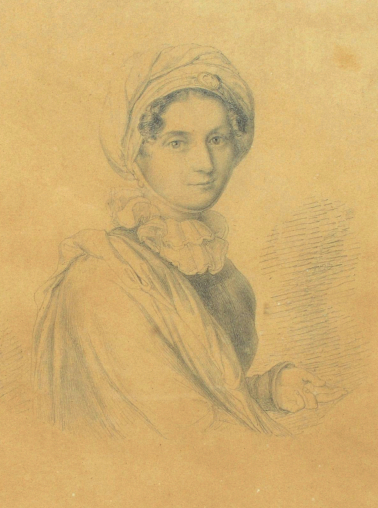Amalie von Helvig

Anna Amalia is the first daughter of the portraitist and miniaturist Christoph Adam Carl von Imhoff, who settled down as a landowner in Mörlach near Nuremberg after returning from the English service in India, and Louise Sophie Franziska von Schardts, Charlotte von Stein’s sister. The daughter was named after her godmother, Duchess Anna Amalia von Sachsen-Weimar-Eisenach. The move to Weimar in the year 1785 signifies a decisive step in the life of the family. After returning from a girls’ boarding school in Erlangen in 1791, Anna Amalie joins the highest intellectual circles of the time already at a young age. She becomes a lady-in-waiting in the court of Duchess Louise von Hessen-Darmstadt. Her twofold talent as painter (especially portraitist) and poet can bloom thanks to early support and the intellectual atmosphere in Weimar. Both Friedrich Schiller and Johann Wolfgang von Goethe encourage her to write and support her development. Her early texts are already presented at court and published in the “Musenalmanach” und the “Horen”. Anna Amalie is, moreover, a guest at Goethe’s “Mittwochskränzchen” (Wednesday coffee circle), i.e. friendly get-togethers that take up the courtly tradition of the “Cour d’Amour” game. Painting and writing go on in parallel through her whole life and are also reflected in her letters, in which she appears as an energetic person who is constantly busy and who always expresses lively interest in art (for instance, for private painting collections in Berlin).
In 1803 Amalie marries Karl Gottfried von Helvig (1764–1844), a Swedish “Generalfeldzeugmeister”, since 1815 lieutenant general of the artillery in the Prussian service. Among the couple’s children only Bror und Dora (Theodora) reach adulthood. After the marriage Amalie von Helvig moves to Stockholm with her husband. Already in 1810, however, she returns, to which contribute not only health problems, but also problems in the marriage. She settles down in Heidelberg. In the years 1814–1816 she visits Sweden for a second time, staying in Stockholm and Uppsala. Her time in Sweden is rich with important literary acquaintances, for example with Per Daniel Amadeus Atterbom, Erik Gustaf Geijer and the writer and salonnière Malla Silfverstolpe. Thanks to her extensive contact with Swedish cultural circles, Helvig becomes an important communicator of Swedish culture in Germany. She is active in this matter especially through translations, one of her most important works being her rendition of “Frithiofs Saga” by Esaias Tegnér.
In 1816 Amalie moves back to Germany and settles down in Berlin. There she leads a literary salon that is frequented by, among others, Friedrich de la Motte Fouqué, Achim von Arnim, Clemens Brentano and Adelbert von Chamisso. In Berlin she lives in the Varnhagens’ neighborhood. Furthermore, she is friends with August Neidhardt von Gneisenau and with Bettine von Arnim, by whom she is also cared for until her death.
In Amalie von Helvig’s works one finds first classical, then Romantic elements. She was primarily a poet, while also publishing stories and translations from Swedish—some of her poems were, vice versa, themselves translated into Swedish. Her most famous poems include “Das Fest der Hertha”, “Abdallah und Balsora. Ein Gedicht in sechs Gesängen”, the epic “Die Schwestern von Lesbos. In sechs Gesängen”. From among her stories, “Helene von Tournon” would be worth mentioning. In addition, Helvig is the author of “Beschreibung altdeutscher Gemählde. Fragmente aus einem Briefwechsel” (1812–1813 in the Deutsches Museum, edited by Friedrich Schlegel) and, together with Friedrich de la Motte Fouqué, editor of the “Taschenbuch der Sagen und Legenden” (1812).
(trans. Pedro Kauffmann Amaral)

Literatur
Heinrich Düntzer:
„Die Dichterin Anna Amalia v. Imhoff zu Weimar“. In: Westermanns illustrierte deutsche Monatshefte 61 (1887), S. 368–383, 526–541.
Jutta Eckle:
„Künstlerische Selbstbehauptung in den Briefen Amalie von Helvigs aus Deutschland und Schweden“. In: Akten des XIII. Internationalen Germanistenkongresses Shanghai 2015. Germanistik zwischen Tradition und Innovation, Bd. 8. Hrsg. von Jianhua Zhu, Jin Zhao und Michael Szurawitzki.
Frankfurt am Main u. a. 2017, S. 159–163.
August Oberreuter:
„Amalia von Helvig als Mittlerin zwischen Schweden und Deutschland“. In: Beiträge zur deutschen und nordischen Literatur. Festgabe für Leopold Magon zum 70. Geburtstag, 3. April 1957.
Hrsg. von Hans Werner Seiffert. Berlin 1958, S. 303–328.